Before Nancy Patterson was confined to a wheelchair, she was an airline pilot.
But when she was diagnosed with a progressive physical disability in 1984, she was forced to watch as her disability robbed her of her ability to carry out the most basic of tasks.
She could no longer open doors or pick things up off the floor. Everyday chores, such as doing laundry or going to the grocery store, now required another person’s assistance. Life in a wheelchair, she quickly learned, prevented her from doing much more than simply walking.
And then she met the dog that would change her life.
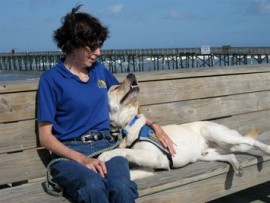
“What Mahler did for me was everything,” Patterson said, her voice colored with fond emotion. “He would open heavy doors – I used to be stuck outside places. He would carry all my groceries, bring them inside and put them on the counter. He could pick up a dime off the floor.”
Mahler is a golden retriever who spent the first two years of his life learning how to improve the lives of disabled individuals like Patterson. He is one of thousands of dogs that have been placed with just as many people nationwide after being trained to perform an enormous variety of tasks.
All of this is done through Canine Companions for Independence, the world’s largest non-profit provider of assistance dogs, which are given to the program’s participants completely free of charge.
These dogs are taught a wealth of commands that make the world a little easier to navigate for those with special needs – and often, in cases like Patterson’s, help them find greater independence.
“When a person helps me, it makes me feel weaker,” Patterson said. “Because I can’t do it myself, and I need someone else to do it for me – but when the dog is helping me, I’m doing it for myself,” she said. “The dog is a part of me. The dog is me.”
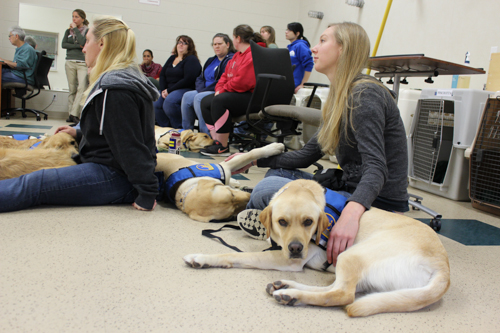
In a large, brightly lit room, about a dozen people sat in a wide circle. Some were in wheelchairs; others were with family members and caregivers. None could resist sneaking glances at the group of golden retrievers and labradors lying calmly at the other side of the room, outfitted in bright blue vests.
“These dogs have no idea what’s happening today,” an instructor told the group. “They do not know that they are potentially meeting their forever families.”
That’s because these dogs had spent the past six months at this very facility, undergoing an intensive training program. There were eight of them, and all together they made up only about 40 percent of the dogs that started the training program six months ago at the organization’s Medford campus – the rest had flunked out for not meeting any one of Canine Companions’ rigorous standards.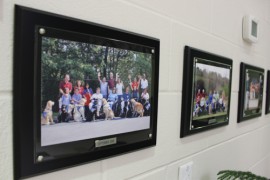
Each dog had received a detailed evaluation from the program’s instructors, mapping out its personality and gauging what kind of person the dog would be best matched with.
And after months of hard work, this class of eight people arrived at the northeast regional center earlier this month to meet their new companions. They came from as far away as Maine to stay in the campus’s hotel-like dorm rooms – completely free of charge – where they would spend two weeks in classes and hands-on training.
At the end of the two weeks, they would go back home with their very own assistance dog – who they were being matched with for the first time today.
“We know these dogs intimately,” the instructor explained. “We’ve known them their whole lives. Trust that we know the dogs and we know you, and that we know what we’re doing to make the best possible match for you.”
The air was thick with excitement. One by one, the instructor called up each member of the circle and announces their match. There was applause and many smiles as each dog was led forward by an instructor, embracing its new owner, several climbing up on wheelchairs to do so.
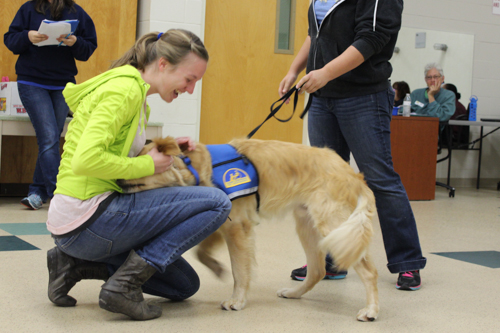
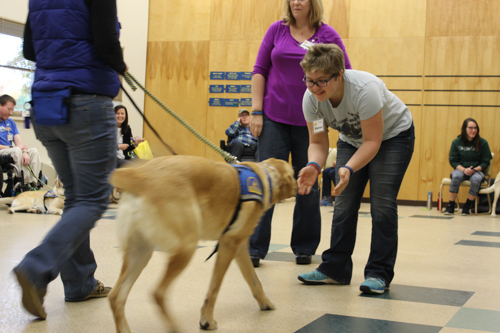
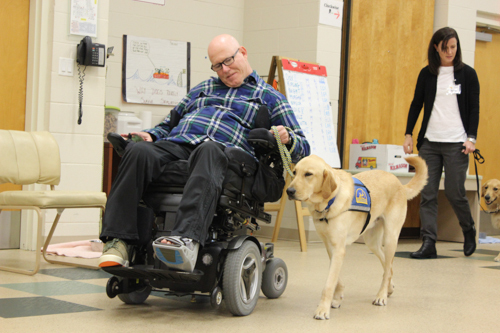
Patterson was one of the eight people who was called to the front of the room. Mahler passed away in June after seven and a half years of service, and she had returned to Long Island to receive her second assistance dog from Canine Companions.
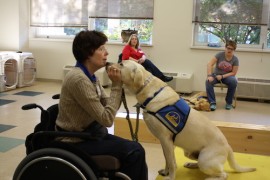
“When I had a pet dog who passed away, I didn’t think I’d want another dog,” Patterson said after she meets her new match, a retriever named Tango. “This was so different. Instantly I knew. He would never want me to give up the independence he gave me.”
“I just want to be that person that he saw,” she added. “This new dog, I know, is going to do that.”
Most of this class’s participants have never had an assistance dog from Canine Companions before. Aside from Patterson, there was only one other – a small young woman with a mop of curly hair, who sat with her mother and sister in the corner of the room.
Her name is Johanna Benthal, a 19-year-old from Jamesport, and she has had more than 85 brain surgeries.
Johanna was 8 years old when she received her first dog from Canine Companions. She has suffered from brain hemorrhages and seizures since she was an infant, thanks to an ultra-rare genetic disorder that causes tumors in her brain.
The disorder has taken its toll. Johanna has both physical and mental impairments. She struggles with reading and writing, and sometimes has a hard time putting her thoughts into words. When she was younger, the constant barrage of surgeries, migraines and doctors appointments would cause her to become withdrawn.
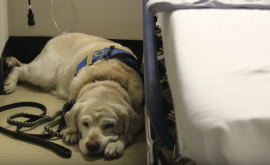
That changed after she was matched with Taffy, a golden retriever who stayed by Johanna’s side for more than 10 years before passing away this past August.
“One of the first things we noticed right away was how Taffy made her open up,” Eileen Benthal, Johanna’s mother, said in an interview last week. “She would shut down, and a doctor would only need to ask her about her dog, and all the sudden she’d start opening up and talking.”
Taffy went everywhere with Johanna – on planes, in restaurants and hospital rooms. She would sleep through the night in Johanna’s bed and alert the Benthals if Johanna was having a seizure in the middle of the night.
“Canine Companions completely blew my expectations out of the water,” Benthal said last week. “When we first applied, I just thought they were giving us a dog, wasn’t that a nice thing to do – but I quickly realized what a great benefit it would be to Johanna after training.”
Now that Johanna is emerging into young adulthood, her needs for her assistance dog are different than they were when she was 8. Her new match, Rae, seems to fit those needs.
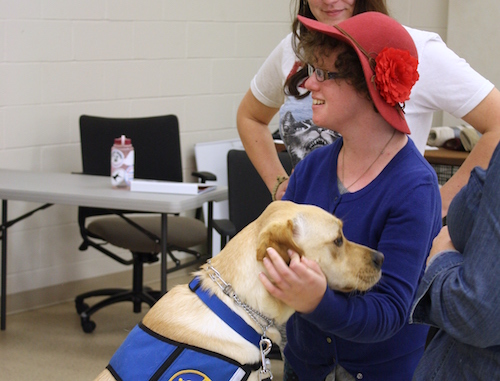
“She’s growing into an active young adult,” Benthal said. “Rae will be able to take Johanna to the next step.”
It’s exactly those kinds of considerations that determine which dogs will be matched with which individuals, according to Laura Ann Dubecky, a Canine Companions instructor.
“We look at everything from home life, work schedule, transportation, energy management of the dog,” she said. “It’s almost like a puzzle.”
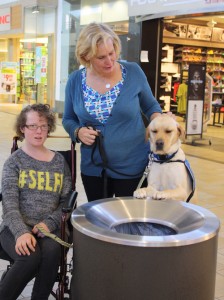
For Johanna, she said, there were many complex factors in determining her match. The Benthals are often traveling, not only for Johanna’s medical appointments but also to speak publicly at workshops and seminars around the country.
“We needed a dog that’s stable in all different environments, from the city to the country to everything in between,” Dubecky said. “We also needed a dog that is extremely good with other animals, because of all their other pets.”
Rae fit all of those qualifications. “Rae’s spent time in Manhattan,” Benthal explained. “She’s been to shows, she was on a boat, she’s done a lot of traveling. Her puppy raisers took her everywhere.”
Puppy raisers are the volunteers tasked with raising the dogs for the first two years of their lives. Puppy raisers receive a dog from Canine Companion’s breeding facility in California, and then spend the next two years teaching them basic commands, bringing them out in public and socializing them.
“The biggest thing is to socialize them so that they’re exposed to anything and everything,” said John Bentzinger, public relations coordinator for the organization’s northeast facility. “That way they’re not freaked out going down the streets of Manhattan, or going on public transportation. It’s the puppy raiser’s job to do all of that.”
After two years, the puppy raisers hand the dog over to Canine Companions, where it goes through the program’s six months of advanced training. The majority of dogs don’t end up finishing the program, which has very strict qualifications for certification. Dogs released from the program either go back to live with their puppy raisers as pets or go to someone on the organization’s extensive waiting list for release dogs.
Hundreds of Canine Companions dogs have still found employment after being released from the program in police departments, hospitals, courtrooms and therapy offices.
Those that make it through graduation get matched with a special needs individual who has gone through the organization’s application and interview process.
“Demand for these highly trained assistance dogs is at an all-time high,” Bentzinger said. “We’re getting about 15 applications a week in the northeast region alone.”
That’s a lot of applications, considering that the facility only graduates four classes each year, with eight to 12 people in each class.
“We need more puppy raisers,” Bentzinger said.
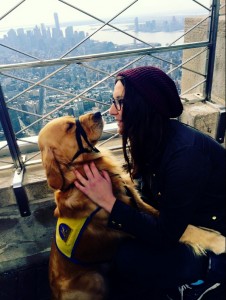
The Benthals saw this need themselves after being matched with Taffy in 2004. Just a year later, their daughter MaryAngela brought home a Canine Companions puppy of her own to raise for the organization.
Ten years later, MaryAngela has raised five dogs for Canine Companions and remains in contact with all the families who have given them a home. She turned over her most recent puppy during the same ceremony that Johanna officially “graduated” the program with Rae.
“This is really the reason I started puppy raising,” MaryAngela said after watching Johanna get matched with her new dog. “Being able to see the end result of the whole process – that’s not only what started me in puppy raising, but what makes me want to keep doing it.
“Seeing all these people receive their dogs right before I have to say goodbye to mine makes it a lot easier,” she said.
Her mother agreed. “People always ask, ‘How could you give the dog up?’ I always have the same answer. I point to Johanna, and I say that we have living in our home a daily example of why we are doing what we’re doing.
“I’ve seen how Jo’s life has benefitted so much from having a working dog,” Benthal said. “It’s so amazing to do that for other people.”
And the effects the dogs can have on the lives of those suffering from disabilities, says Dubecky, are “tremendous.”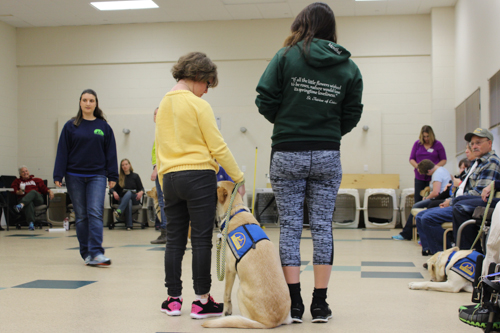
“I’ve seen people whose attendant care hours have gone down,” she said. “Kids become more social and more confident. They do things they never thought they could do. The confidence of not having to rely on someone – it does amazing things for people.”
Patterson is a prime example of that. She may no longer be flying airplanes, but becoming involved in Canine Companions has added new meaning to her life.
“My life was great before, but my life is great now,” she said. “It’s just a different life.”
With the help of Mahler – and now Tango – she conducts outreach for the organization’s chapter in Maryland, where she lives. She works with wounded veterans and connects them with resources in the organization.
“A lot of people don’t think they’re disabled enough for a dog, or that it’s a weakness,” Patterson said. “But it really is a strength. They give these dogs to really strong people, and then you only get stronger.”
The survival of local journalism depends on your support.
We are a small family-owned operation. You rely on us to stay informed, and we depend on you to make our work possible. Just a few dollars can help us continue to bring this important service to our community.
Support RiverheadLOCAL today.
































